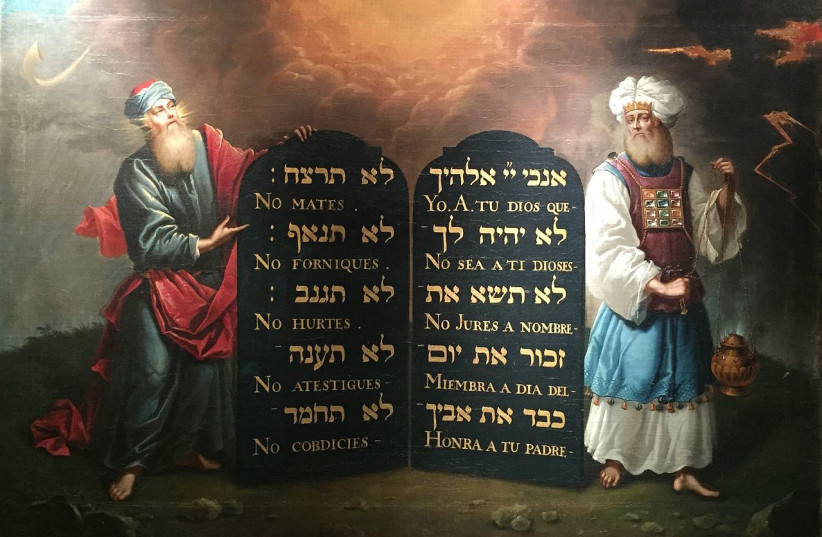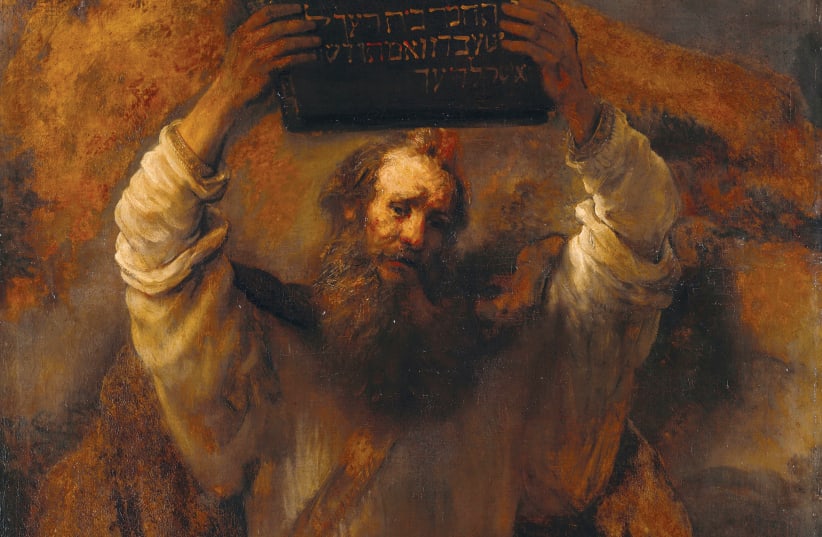What makes Judaism different from all other religions? And does this explain Jew-hatred in Christianity and Islam? How is Jewish civilization different from others? Technically, one can cite the origins of empires and city-states, the development of writing, and the use of sophisticated tools. Tribal monarchies in Mesopotamia, Egyptian dynasties, Hittites and Hurrians all contributed to the development of early cultures – and all disappeared, leaving little trace of what they accomplished. There was, however, a single exception, a group of people who created a spiritual civilization, based on the belief in a divine covenant, One God, expressed by Abraham, Isaac and Jacob, and a book (five books, actually), Torah, and an extensive library thereafter, Tanach (prophesy and history), Talmud (discussions of the Oral Law, Halacha), and vast libraries of interpretations.
Having defied their Egyptian masters, survived hardship and devastating plagues, the Jewish people-to-be marched out of slavery, passed through the Red Sea and watched the pursuing army drown before their eyes. They had accomplished the impossible: They had escaped while the army of their oppressors was destroyed.
Led by Moses, Aaron, Miriam and the elders, they embarked on a treacherous journey across the desert toward Eretz Yisrael, the land that God had promised to them and their forefathers.
Former slaves, they were designated “a nation of priests,” a “holy people,” a moral emblem “chosen” to transmit Torah and conquer Eretz Yisrael, where they were to build a society dedicated to God. At least, that was the plan. This could not have been done without a unifying source, a structure that was passed down from generation to generation – Torah, the unique mechanism for spiritual transformation.
Torah, the unique mechanism for spiritual transformation

Written first on stone tablets (the 10 Commandments) and then on scrolls of parchment, preached and witnessed, Torah introduced a new and unique concept: ethical monotheism, God-consciousness, awareness. This radical, revolutionary innovation demanded critical self-inquiry and the assumption of individual (and sometimes collective) responsibility. Unprecedented, it did not evolve; it did not emanate from reason or popular will. It was the basis for Man’s encounter with God.
Jews were the first – and, for a long time, the only – people and civilization to postulate the belief that Man has a purpose, that all life is sacred and significant, that the definition of human existence is the search for truth and transcendence. Others also asked fundamental questions of human existence, but Jews alone insisted on ethical monotheism – one God, the source of existence – as a holistic, organic way of life. Embedded in a system of laws and practices – Halacha – every action expressed one’s relationship with God, a dedication to transforming self and society, tikkun olam (repairing the world).
This message, expressed in the Torah, demanded radical creative thinking, consciousness as the source of ethical behavior – not primarily because it was “right” but because it represented one’s relationship to God, the belief that life was based on a spiritual essence. Consciousness – fully focused attention, the desire to achieve one’s spiritual potential – defined the interaction between human and divine.
Uniquely and persistently, Jews set forth an ideal – kedusha (holiness) – not as an abstraction but as conscious acts of human kindness and moral behavior infused in daily life which defined the essence and nature of being human. In the language of Kabbala – chochma, bina and da’at. This became the basis of Jewish civilization, the Empire of Mind.
Empires come and go, often destroying as much as they contribute in their quests for power and wealth. Jewish empire was different. It valued the cognitive rather than the material; its focus was consciousness and intention. Rooted in this world, it was dedicated to transcending it. It was not what you owned, but what you thought that mattered. Passed down through generations, based on texts and traditions, it wove faith, practice and prophesy.
Yet another expression of brachot might be swearing oaths; commitment to them, their importance and their annulment – the central theme of the Kol Nidre service on Yom Kippur – intensifies the notion of relationship and kavanah (intention).
It survived exile, dispersion and trauma because it had a central core – Torah – accompanied by interpretations, historical encounters, homilies and discussions of law and ethics. This literature provided the structure that maintained a sense of cohesion and continuity for Jews wherever they lived – the common thread of survival.
Following the downfall of the Second Commonwealth, humbled and helpless, Jews created a world view that transcended pogroms and persecution, expulsion and destruction. Expelled from one country to another, they understood the fragility of protection and existence, and the importance of learning and text.
Instead of territorial empire, Jews created an Empire of Inquiry, a reverence for the question, even in the absence of answers, a devotion to scholarship, intellectual curiosity, homage to curiosity – to mindfulness.
Restricted from participating in the physical world defined by landed wealth and power, Jews relied on the dominance of thought, the intricacies of problem-making and problem-solving that postulated the Mind of God and the Mind of Man in divine communion.
Wherever they were driven, despite suffering, dislocation and destruction, Jews survived as a people because they were citizens of a nationality greater than any that existed, or will exist; one that has no boundaries in space or time, yet is rooted in everyday life, the ultimate creative process, the Monarchy of Mind.
Jews saw themselves as different, not because of what they were as a distinct group but who they were, what they thought about. More than achievements in the non-Jewish world, Jews created a culture of learning, the sovereignty of spirit – and that set them apart.
No matter how well they integrated and adapted, Jews were always considered aliens because they treasured the ability to read and write, the desire to know. Unlike most other groups, it would be impossible to imagine a Jewish home, even that of a peasant, without books. Reverence for learning, even by those who were semi-literate, was a fundamental Jewish trait.
This culture of learning provides a descriptive map of Jewish development and an explanation for the geography of innovation, speculation and intuition – a kind of inherent genetic disposition to raise the most fundamental questions of mankind and civilization: who are we, where are we going, and why?
Magnificent mosques and churches, Buddhist and Hindu shrines, meditation/retreat centers flourish throughout the world; all of them, by virtue of those who pray there, share sacredness in a multi-cultural, multi-faith society; holiness is not exclusive. Does it matter to whom one prays? Is one faith purer than another, its adherents more righteous, and its practices more beneficial? What, then, makes Judaism different?
Walk into a church, mosque or shrine and what do you see? The symbols of that faith, beautiful architecture, clean floors, prayer rugs, a sense of reverence and order.
When entering a beit midrash or shul, what do you see? Books, lots of them; and, when not praying, men engrossed in studying a text; often little or no aesthetics to distract, a culture of learning. Impressive synagogues were built throughout Jewish history and, of course, the magnificent First and Second Temples in Jerusalem; but architecture wasn’t the point. The Holy of Holies symbolized a relationship with God. More than anything else, discipline, reverence for study and inquiry mark Jews as different. Questions, not only answers, are important.
For three millennia, Jews were known as “the People of the Book” – Torah. For a thousand years, they were the only people with a portable, accessible sacred text open to all. Later, Mohammed called Jews and Christians “people of The Book,” to distinguish them from bookless pagans. Books are at the core of what it means to be Jewish. They provide the historical link between generations, the continuity of a people, the basis of Halacha, the laws of everyday life for Jews.
Other religions have holy books, Bibles, philosophies and pathways of morality. The basis of religious life is faith. Judaism demands commitment to intellectual curiosity, an intense if unsettled relationship with God, the sanctification of daily life in a world of good and evil, and dedication to the idea of human dignity. That is the essence of the Jewish soul.
A note on texts: The earliest renditions of Jewish sacred writings are the Dead Sea Scrolls, which include all the books of the Tanach, except Esther, some in multiple copies. Dating from the mid-second Temple period (many during the Hasmonean reign), it is unlikely that they were written without precedents. They would have been rejected by the Jews of Israel and Babylon – especially the centers of learning, yeshivot (academies) and institutions like religious courts and Sanhedrin. Logically, this pushes back textual origins at least to the time of Ezra (the Scribe) and the Babylonian Exile, in the early 6th century BCE, when (apparently) the dominant form of Hebrew script changed from Ivrit to Ashurit.
While relatively few Jews may have been able to read and write prior to the exile, it seems reasonable that Jewish sacred writings, especially Torah, existed in some form that was accepted by all Jewish scholars and scribes, at least since the early monarchical period, since it would have been nearly impossible to introduce and impose an innovation on the entire Jewish people that would be accepted without debate, comment and dispute.
Although some Jewish texts have been found from the First Temple period, there are archaeological confirmations of Tanach and Jewish history during this era. Arguably, oral Torah, rabbinic discourse and interpretation that accompanied Torah, written in Mishnah and Gemarah (Talmud), commented upon by great sages and thousands of scholars has been disputed since the late Second Temple period and during the late Gaonic period (by the Karaites). The existence and survival of a tradition of authenticity and authorization, the world of Jewish law, Halacha, has been the mechanism for transmitting and inculcating the written word, reverence for learning, and the search for truth. That is the basis of what it means to be a Jew. To paraphrase Hillel, not only to believe, but to do; and in order to do, learn.
All religions that followed the inception of Judaism included sacred texts and a tradition of study and learning. Jews and Jewish tradition, however, placed universal education and study at the core of a “religious life.” One can be a good Christian, Muslim, Hindu, or Buddhist without knowing and studying texts. For Jews, the fact that all spiritual movements focus on ethics and morality, making life meaningful, is a triumph of the human spirit. A path laid out thousands of years ago, its origins are in Torah. Judaism does not claim that it is the only way to God. It says, however, that there must be one – and without it, life is not worth living.
The unique and enduring legacy of Torah and the Jewish people is to create in the womb of consciousness a new concept of holiness embedded in everyone and everything, the idea of a holy people chosen for a specific spiritual mission, a potential that could be revealed, a connection to the Infinite and Eternal, an ever-evolving awareness that has defined the dimensions of humanity and the human condition. ■
The author is a PhD historian, writer and journalist living in Jerusalem.
